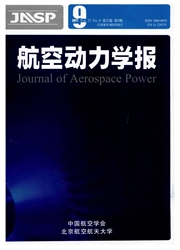

 中文摘要:
中文摘要:
采用时间模式对不可压平板边界层从层流到湍流的转捩过程进行了直接数值模拟.分析结果表明:在层流-湍流转捩的突变过程开始之前,已经产生非线性作用;二维波与三维波的幅值实际增长率也偏离线性状态,而且在二者之间存在能量转移的迹象.在突变过程中,速度变形率对总应力的影响较大,在转捩结束后雷诺应力对总应力的影响比较显著.研究表明:正是由于大量谐波被快速激发并增大,导致了雷诺应力及其法向梯度也快速增大.这使得平均流剖面快速被修正,流动快速转为湍流.
 英文摘要:
英文摘要:
Temporal mode was used to simulate numerically the breakdown process of laminar-turbulent transition and the fully developed turbulence in an incompressible boundary layer on a flat plate. The analysis of results showed that, before the breakdown process of laminar-turbulent transition, the growth rate of amplitudes of a two-dimensional and two oblique Tollmien-Schlichting waves has already deviated from the linear growth rate due to nonlinear interaction, and energy transfer existed between different wave modes. During the breakdown process, the rate of strain had great effect on the general stress, and the Reynolds stress has remarkable effect on the general stress after transition. The conclusion indicates that many more harmonics will be quickly excited, and their amplitudes will also increase quickly, the direct consequence is that the Reynolds stress and its corresponding normal-wise gradient increase greatly, which in turn further modifies the mean flow profile in a much faster pace, leading to the breakdown of the laminar flow with a catastrophic nature.
 同期刊论文项目
同期刊论文项目
 同项目期刊论文
同项目期刊论文
 期刊信息
期刊信息
